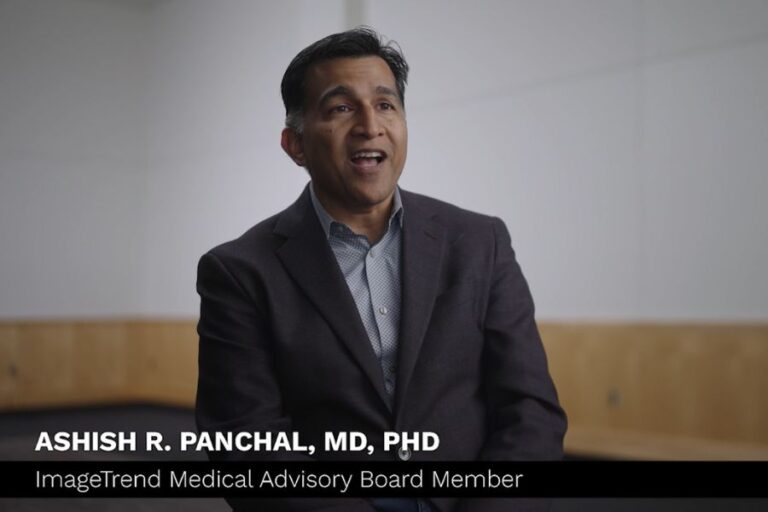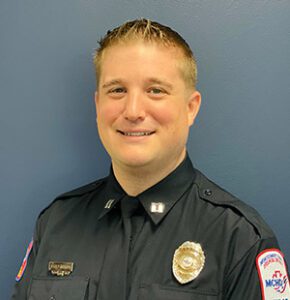When EMS clinicians respond to a call, their focus is clear: provide care, stabilize the patient, and get them the help they need. But behind every action taken in the field is an opportunity to shape something bigger—how we understand emergencies, treat patients across the country, and support the people delivering that care.
Dr. Ashish Panchal, EMS physician, national research leader, and member of ImageTrend’s Medical Advisory Board, believes that’s where data comes in. “Data gives us an idea of what’s actually happening. It tells the story of EMS,” he explained. “So many times when we think about the story of EMS, we think about the anecdotes… it doesn’t really help us understand how we treat large populations.”
In a recent Connect25 interview, Dr. Panchal shared how high-quality EMS documentation, paired with large-scale data, is driving real progress in clinical care, from whole blood use and airway management to mental health and workforce stability. You can scroll below to see the full video.
Telling the Bigger Story of EMS
With a background in emergency medicine and research leadership at the National Registry, Dr. Panchal is deeply involved in using data to improve care across diverse communities.
“The ImageTrend dataset allows us to have vision into a large representative population of EMS clinical care, so that we can start making real implementation plans that can affect every single person in every home in the United States,” he said.
Whether it’s a person living in “rural South Dakota” or “urban Columbus, Ohio,” access to comprehensive EMS data can help ensure care strategies are effective across populations.
Improving Trauma Care with Whole Blood
One area where data is essential? Trauma care. “The number one topic that comes up is the use of whole blood,” Dr. Panchal said. “Can we take what we’ve learned on the battlefield and apply it in our clinical, civilian populations to improve care?”
Whole blood transfusion is gaining traction in EMS systems as a life-saving intervention for patients experiencing severe trauma. But its adoption is far from universal, and understanding where and how it’s working requires strong data.
“We’re looking at people donating, let’s be honest, their life’s blood to improve the outcomes of other people,” Dr. Panchal said. “That is a gift that we have to be respectful of… The only way we can do that is by leveraging large databases so we can understand exactly what’s happening and save the most number of lives.”
Recent momentum is being driven by compelling outcomes. As highlighted in this overview of whole blood in EMS, some agencies have reported significant reductions in trauma-related deaths after launching prehospital transfusion programs. Yet barriers like supply shortages, regulatory requirements, and storage limitations still slow broader adoption.
To help agencies address these hurdles, organizations are turning to smart documentation and tracking workflows built within systems like the ImageTrend Platform. From automated review alerts to configurable tools, agencies are developing scalable processes that ensure oversight, compliance, and reliable access to data.
Better Data, Better Guidelines
With experience developing American Heart Association and prehospital clinical guidelines, Dr. Panchal understands how data quality directly shapes clinical guidance.
“Even when we talk about airway management… we have a hard time really saying that this is the exact right approach, and a lot of that has to do with data quality,” Dr. Panchal explained.
That’s beginning to change thanks to improvements in both technology and culture. “Our EMS clinicians are starting to do a great job of giving us good documentation and good data management,” he said. “If you have a system that’s designed around the EMS clinician and the job they do, you will get good data.”
ImageTrend’s all-in-one platform helps make that possible, with Dr. Panchal emphasizing that flexible systems improve both data quality and outcomes. “We can not only enter good data, but then look back and see—are we actually making a system that works for them? That customization… really moves care forward.”
Research as a Storytelling Tool
Despite the growing role of data in EMS, some providers still feel intimidated by the idea of research. Dr. Panchal wants to change that mindset.
“One of the fundamental things that I tell people— all research is telling a story. It’s telling a story about something you really care about, about EMS.”
That story might begin with a process improvement or a protocol that led to better outcomes. “That’s research,” he said. “There’s just pieces in there that we can put together, and we can work together and move forward.”
Understanding the Workforce Crisis
While clinical care is a key focus, Dr. Panchal is also using data to address a growing crisis within EMS: the workforce itself.
“We have EMS clinicians who are suffering because of the work they do,” he said. “We’ve seen it in mental health.”
Through collaborations with ImageTrend, he and other researchers are beginning to examine questions like: “What’s happening to our EMTs and paramedics? How are they getting into our system? Why are they staying? Why are they leaving?”
These aren’t just operational challenges, they reflect the human cost of the profession. Dr. Panchal believes research can play a vital role in understanding and supporting the people behind the work.
“These are our people,” he emphasized. “We need good answers. And this is what research is all about—again, telling the story of EMS… so that we can save our own lives, and save our industry, so that we can be out there to help the next day.”
Watch the Full Interview
For more insights, watch the full Connect25 video featuring Dr. Ashish Panchal. Learn how data is shaping the future of EMS, one decision at a time.




